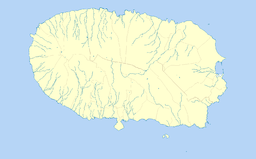Fort of São João (São Mateus da Calheta)
| Fort of São João (Forte de São João) | |
| Fort of the Biscoitinhos | |
| Fort (Forte) | |
 The remains of the ancient Fort of São João/Biscoitinhos that was part of the coastal defenses during the 16th century | |
| Official name: Forte de São João/Forte dos Biscoitinhos | |
| Named for: Saint John | |
| Country | |
|---|---|
| Autonomous Region | |
| Group | Central |
| Island | Terceira |
| Municipality | Angra do Heroísmo |
| Location | São Mateus da Calheta |
| - elevation | 3 m (10 ft) |
| - coordinates | 38°39′15.75″N 27°16′10.12″W / 38.6543750°N 27.2694778°WCoordinates: 38°39′15.75″N 27°16′10.12″W / 38.6543750°N 27.2694778°W |
| Length | 6 m (20 ft), Southwest-Northeast |
| Width | 3 m (10 ft), Northwest-Southeast |
| Architects | unknown |
| Style | Medieval |
| Material | Basalt |
| Owner | Portuguese Republic |
| For public | Public |
| Management | Instituto Gestão do Patrimonio Arquitectónico e Arqueológico |
| Operator | Junta de Freguesia de São Mateus da Calheta |
| Status | Unclassified |
 Location of the fort within the municipality of Angra do Heroísmo | |
Fort of São João (Portuguese: Forte de São João), also known as Fort of Biscoitinho (for the lava rock formations along its coastal frontier), is a medieval fort, in the civil parish of São Mateus da Calheta, in the municipality of Angra do Heroísmo, on the Portuguese archipelago of the Azores.
History

The redoubt was not identified in the early coastal defense plan resulting from the Portuguese succession crisis of 1580, nor in the 1581 defensive map elaborated by Tommaso Benedetto, which was executed by Ciprião de Figueiredo e Vasconcelos, corregador of the Azores.[1]
Similarly, the project was never elaborated by successive military commanders, including Sergeant-Major João António Júdice (1767), Infantry Captain Francisco Xavier Machado (1771-1772), or activities of Manoel Correa Branco (1776). Plans by José Rodrigo de Almeida, also lack any mention of this platform, during the period leading to the Liberal Wars (1818 to 1820), when Captain-General Francisco António de Araújo e Azevedo reinforced coastal defenses, repair and reconstructing several of the forts in the Azores.
The first reference to this fort, then referred to as Biscoitinhos appeared in the 19th century, and may have mistakenly referred to the Redoubt of Poço, then mentioned by Júdice (1767). More than likely it was confused with the Fort of Açougue (Portuguese: Forte do Açougue) ", and identified by Gaspar Frutuoso at the end of the 16th century.
In the context of the Liberal Wars (1828-1834) the Fort of São João was repaired, leading to the 1862 reference by the Baron of Bastos, who reported that the fort was "a simple barbette with an 18-calibre; it has no lodging or magazine".[2]
By 1881, however, it had been abandoned and was in ruins.
By the 20th century, the retaining walls of the redoubt were reinforced and consolidated by the parish council of São Mateus.
Architecture
It is situated between the historical Fortress of São Mateus da Calheta and Fort of the Church, with which it cooperated in the defence of the bay of São Mateus, on the southern coast of the island of Terceira.
Technically, it is classified as a land battery, since it is not enclosed fortification, but a semi-circular base. Although originally equipped with one piece of artillery, protected by a barbette, the masonry structure was without any ancillary buildings.
References
- Notes
- References
- Bastos, Barão de (1997), "Relação dos fortes, Castellos e outros pontos fortificados que devem ser conservados para defeza permanente", Boletim do Instituto Histórico da Ilha Terceira (in Portuguese), LV, pp. 272–274
- Drummond, Francisco Ferreira (1981), Anais da Ilha Terceira (fac-simil. da ed. de 1859) (in Portuguese), Angra do Heroísmo (Azores), Portugal: Secretaria Regional da Educação e Cultura
- Faria, Manuel Augusto (14–15 June 1997), "Ilha Terceira – Fortaleza do Atlântico: Forte dos Biscoitinhos", Diário Insular (in Portuguese), Ponta Delgada (Azores), Portugal
- Júdice, João António (1981), Revista dos Fortes da Terceira (ed. facsimile 1883) (in Portuguese), V, Ponta Delgada (Azores), Portugal: Arquivo dos Açores/University of the Azores, pp. 359–363
- Machado, Francisco Xavier (1983), Revista dos fortes e redutos da Ilha Terceira - 1772 (in Portuguese), Angra do Heroísmo (Azores), Portugal: Secretaria Regional da Educação e Assuntos Sociais/Gabinete da Zona Classificada de Angra do Heroísmo
- Martins, José Salgado (2007), "Património Edificado da Ilha Terceira: o Passado e o Presente", Atlântida (in Portuguese), LII, p. 18
- Mota, Valdemar (1993–1994), "Fortificação da Ilha Terceira", Boletim do Instituto Histórico da Ilha Terceira (in Portuguese), LI-III
- Neves, Carlos;; Carvalho, Filipe; Matos, Artur Teodoro de (1992), "Documentação sobre as Fortificações dos Açores existentes nos Arquivos de Lisboa – Catálogo", Boletim do Instituto Histórico da Ilha Terceira (in Portuguese), L
- Pego, Damião Freire de Bettencourt; Almeida Júnior, António Belo de (1996), "Tombos dos Fortes da Ilha Terceira", Boletim do Instituto Histórico da Ilha Terceira (in Portuguese), LIV, Direcção dos Serviços de Engenharia do Exército
- Vieira, Alberto (1987), "Da poliorcética à fortificação nos Açores: introdução ao estudo do sistema defensivo nos Açores nos séculos XVI-XIX", Boletim do Instituto Histórico da Ilha Terceira (in Portuguese), XLV (II ed.)
